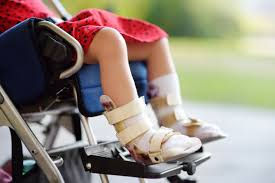
Neuromuscular Conditions
NEUROMUSCULAR CONDITIONS
CEREBRAL PALSY:

Cerebral palsy can cause changes in muscles, joints, and bones as a child grows, leading to muscle spasticity, muscle contractures, joint stiffness, walking difficulties, and deformities in the hip, spine, foot, and ankle. Parents often search for cerebral palsy treatment options, orthopedic surgery for cerebral palsy, spasticity management in cerebral palsy, foot and ankle surgery in CP, and hip dislocation treatment. Managing these challenges requires a multidisciplinary team approach with orthopedic doctors, physiotherapists, occupational therapists, and families working together. An essential part of care is hip surveillance, involving regular check-ups and X-rays to monitor hip stability and prevent silent hip dislocations. Treatment plans may include physical therapy for cerebral palsy, bracing and walking aids for cerebral palsy children, botox or other injections to relax tight muscles, and in some cases, bone or hip surgery like tendon lengthening or osteotomy. The goal is to improve mobility, reduce pain, prevent deformities, and help your child stay as comfortable and independent as possible to participate fully in daily life.
MUSCULAR DYSTROPHIES

Muscular dystrophies are conditions where muscles gradually become weak, causing muscle weakness in kids that can also affect bones and joints, leading to contractures (joint stiffness), scoliosis (spine curvature), walking difficulties, and fragile bones. Parents often search for muscular dystrophy symptoms in children, muscular dystrophy treatment options, and orthopedic care for muscular dystrophy to understand how to support their child. Orthopedic management includes regular physical therapy for muscular dystrophy, use of braces for muscular dystrophy children, and close monitoring of the spine and hips to prevent deformities. In some cases, orthopedic surgery for muscular dystrophy may be needed to release tight joints or correct spinal or hip deformities. Families frequently look for information on wheelchair and mobility aids muscular dystrophy, contracture treatment, and when to see orthopedic doctor muscular dystrophy. The best care comes from a multidisciplinary team of orthopedic specialists, neurologists, physiotherapists, rehabilitation experts, and families working together to keep the child as mobile, independent, and comfortable as possible.
SPINA BIFIDA

Spina bifida is a condition where the spinal cord and surrounding structures don’t fully develop, affecting how a child’s legs, muscles, and joints grow and function. Parents often search for spina bifida treatment options, orthopedic care for spina bifida, and child with spina bifida walking problems to understand how to manage these challenges. Due to weak or imbalanced muscles, children may develop orthopedic issues like hip dislocation, foot deformities (including clubfoot or high-arched feet), scoliosis (curvature of the spine), and difficulties with walking and balance. Orthopedic management includes regular monitoring, physical therapy for spina bifida, use of braces or splints for spina bifida children, and sometimes orthopedic surgery for spina bifida to correct deformities or improve mobility. Families often look for information on walking aids for spina bifida kids, spina bifida foot surgery, and when to see orthopedic doctor spina bifida. A multidisciplinary team approach— involving orthopedic specialists, neurosurgeons, urologists, physiotherapists, and families—ensures treatment is personalized, aiming to improve the child’s comfort, mobility, independence, and overall quality of life.
Dr. Gourav Jandial has extensive experience caring for children with complex neuromuscular conditions such as Cerebral Palsy, muscular dystrophy, and spina bifida. His approach emphasizes a multidisciplinary team model, collaborating closely with physiotherapists, occupational therapists, pediatricians, and families to develop holistic treatment plans that address each child’s unique needs. Trained at British Columbia Children’s Hospital under experts like Dr. Kishore Mulpuri, Dr. Christopher Reilly, and Dr. Christine Alvarez, he gained invaluable exposure to advanced, evidence-based methods that integrate medical, surgical, and rehabilitative care. This international experience has enriched his expertise and strengthened his commitment to compassionate, comprehensive care focused on improving comfort, mobility, independence, and quality of life for every child.